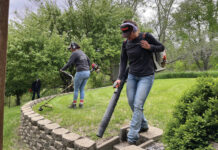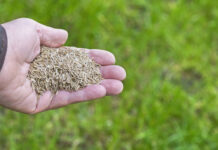One-third of all residential water is used by landscape irrigation systems, according to the U.S. Environmental Protection Agency. Some experts estimate that 50 percent of that water is wasted due to evaporation, runoff and improperly operating landscape irrigation systems. One broken sprinkler can easily waste 300 gallons of water per night.
For landscape companies that offer irrigation maintenance services, that’s great news. Making clients’ irrigation systems more efficient can be some of their most lucrative work. However, customers must be educated enough to understand that proper maintenance methods carried out at properly scheduled intervals can save them a substantial amount of water, which translates into saving a bundle of money. Of course owners must price these services correctly to make sure they are profitable.
Educating the customer
“We believe customers will pay top dollar for a service if they understand the value of what they are receiving,” says Kurt Thompson, irrigation expert at Orlando-based Massey Services, one of Florida’s largest outdoor services company. “It’s very important to educate customers on the benefits the program offers, and that it’s not just a ‘one-size-fits-all’ strategy.”
When it comes to educating customers, Massey provides a complete initial evaluation of its customers’ irrigation systems zone by zone, complete with a detailed report and advisory. Service visits include evaluating the condition and performance of the components, and making any necessary adjustments or repairs. Technicians inspect sprinklers twice annually, measure water pressures and test controllers and all of the systems’ electrical components. The company also provides a preferred customer discount on future irrigation repairs.
“Customers who purchase our services keep us because they understand the value of the landscape relative to the overall value of their homes,” says Thompson. “During the recession we saw more consumers invest their discretionary spending dollars back into their homes.”
There will always be those homeowners who don’t understand how their irrigation systems operate, says Thompson. “We explain to our customers that their irrigation systems are more than assembling plastic parts to get the water to spray. It’s the placement of the components, the hydraulics to make them work the way the manufacturers intended, the electronics to control the system. All of this must be done to efficiently apply water. We must also adjust these components to the dynamic conditions that happen in the landscape.”

Richard Restuccia, vice president of landscape solutions at Jain Irrigation, says the biggest challenge he often faces is with property owners relying upon systems installed 15 to 20 years ago. It is difficult to convince them to invest the money to upgrade their systems. “Unfortunately, these customers are convinced that it costs less to waste water than to improve or upgrade their systems,” says Restuccia.
Jeff Watson, district irrigation manager of Orlando, Florida-based Heron Irrigation, learned that giving customers three pricing options works for him. “The first is to quote the minimum repairs to bring their system up to operating standards,” he explains. “The second is to quote a full irrigation conversion to save water, and the third is to quote the maintenance.”
Heron Irrigation performs an initial system inspection and repair prior to implementing any irrigation maintenance program. The company offers a seven-point irrigation analysis for its customers. Technicians go through each zone and adjust sprinkler heads to ensure accurate head-to-head coverage, and replace broken sprinkler heads at no charge. They calibrate irrigation controllers for correct watering times and duration. After each visit, technicians leave notes explaining the adjustments and repairs they made. The company gives a 15 percent discount on any additional repairs beyond what is covered on the maintenance program. Bi-monthly maintenance includes a detailed inspection and free head replacements, as well as seasonal adjustments to watering schedules. All services are discussed at the time of sale to let customers know their options, and the improvements they can potentially make on their water usage.
“We have end-of-year goals for what percent of profit we would like to have. We want to ensure we are not working for free or below cost,” stresses Thompson. He adds that whenever he gets the objection, “You are too expensive,” his rebuttal is, “‘Ms. Jones, what did you expect to pay and what company are you comparing us to?’ The fact is that they don’t know. Those type of customers are looking for a deal and may not be the customers we want.”

Whenever Massey irrigation sales representatives price their irrigation maintenance services, they also stress their value. “We often show customers our rate card to let them know that we are not making up numbers,” explains Thompson. “We are charging them what we charge everyone. Don’t get me wrong, we try to help all of our customers in any way we can. We have many ways for customers to save money or receive discounts toward our services.”
Ty Van Ryswyk of Hawkeye Irrigation in St. Louis is also convinced that the more his customers know about their systems, the more likely they are to sign up for professional maintenance services, such as system startups, winterization, mid-season inspections and backflow tests.
“You would be surprised how much water is wasted due to homeowners not knowing how to set their controllers to the correct settings. Our biggest waste of water over the years would have to be customers using high-run and multiple start times, sometimes running almost all day,” continues Van Ryswyk.
Thompson adds that the irrigation industry looks for 20 to 40 percent lower water use for “complete” systems. “We have estimated our program reduces 30 percent of water waste,” he says. Restuccia concurs that most of the time you don’t have to work very hard or charge your customers much money to get a 20 to 25 percent savings.
Know what to charge
The biggest challenge contractors face when pricing irrigation maintenance services is understanding what other professional trades charge for comparable services, says Tom Barrett, principal of Indianapolis-based Green Water Infrastructure. For the past 30 years, Barrett has operated a consulting company integrating water resources in sustainable site development. He is also president of BarrettWorks, a business consulting firm.
“Many irrigation contractors fail to look outside of their world to understand what other trades are charging,” says Barrett. “Plumbing, homebuilding and welding trades all have varying pay scales that are dependent upon years of experience, degree of technical difficulty, amount of specialization and certifications. Additionally, there are huge regional differences in irrigation maintenance pricing.”
Barrett is convinced that most irrigation contractors don’t truly understand the “true costs” of providing their irrigation services. “Contractors who price based on what others are charging without fully understanding how much their full burden hourly rate is can be in for an abrupt shock,” he says. “The shock may be positive if they are extremely efficient, or it may be devastating if they are not extremely efficient.”
Before Van Ryswyk establishes his prices he looks first at obvious expenses. These, of course, include wages, gas and materials. He then sits down and figures in the cost of such things as vehicle maintenance, insurance, office supplies and other less obvious expenses. “My maintenance techs know they need to bill out a certain amount for an eight-hour day or I have lost money,” he says. “It’s a team effort to make sure that happens – from the phone call all the way out to the job site.”

Barrett and Restuccia agree with Van Ryswyk that controlling labor expenses, the biggest cost in providing the services, greatly affects job profitability. “Highly efficient companies can bill in excess of 90 percent of their total labor including management and administrative overhead,” says Barrett. “On the other hand, in working with less efficient companies I see labor productivity below 50 percent. Generally speaking, if a company is billing in excess of 70 percent of their total labor hours they are usually very profitable.”
Van Ryswyk used to worry too much about his pricing, keeping it too low for too long. “I wanted to be fair to my customers, but if you don’t charge an appropriate amount, you will find yourself struggling to make payroll. Customers are willing to spend what they think is fair if they are getting the proper service and attention.”
Restuccia recounts one particularly costly experience in that regard. “I was involved in one project with more than 300 controllers. Finding all of them for replacement was an issue. Even though we were told about their locations, they were mostly hidden. By taking two extra minutes to find each controller, that added an extra 10 hours of labor.”
When Restuccia ran into a similar situation, he planned his estimates differently. This customer owned multiple building sites each with its own irrigation system. He bid on one site initially. Then, after learning the time involved to find the hidden underground irrigation parts on the first unit, he was able to accurately bid on the rest.
Post-recession outlook
Over the last five years, the economic recession put all irrigation maintenance prices “on hold,” Barrett says.
“We are just starting to experience moderate increases in irrigation maintenance pricing,” he says. “Many irrigation contractors are starting to experience a profit squeeze. Over the last five years, operating costs and overhead costs have increased, and skilled labor is more difficult to obtain. Over the long-term, prices will have to increase if a contractor wants to stay in business.”
Restuccia says labor and profit margin tend to decrease with a recession. At Jain, the cost of water has increased enough so that the company can often show customers a ROI of 24 to 36 months on an irrigation upgrade. “This makes pricing less of a challenge,” he says.
Van Ryswyk expects 2015 to be a good year for Hawkeye. As he says, “We will try to keep our prices fixed for the near future and focus on gaining customers with our daily installs, and, more importantly, with our customers’ referrals.”











![[VIDEO] Dickies®: Discover Workwear That’s Anything But Uniform](https://turfmagazine.com/wp-content/uploads/2023/06/1647663814-4b1a2a7742790a9b1e97a3b963477850192e1d6a9dfba9b07214a77bae25d6e3-d-218x150.jpg)




























![[VIDEO] Dickies®: Discover Workwear That’s Anything But Uniform](https://turfmagazine.com/wp-content/uploads/2023/06/1647663814-4b1a2a7742790a9b1e97a3b963477850192e1d6a9dfba9b07214a77bae25d6e3-d-324x160.jpg)